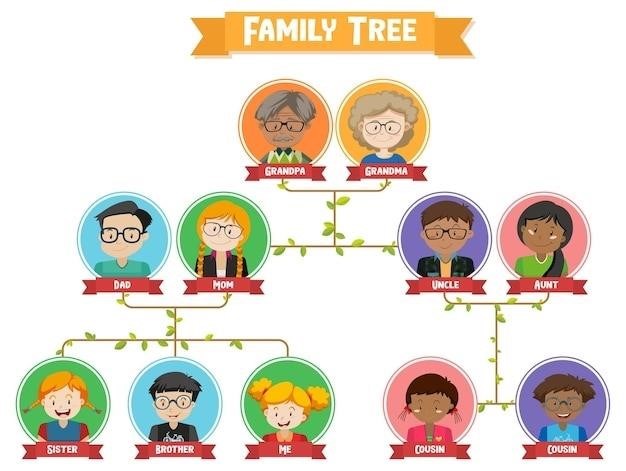
Jesus Family Tree⁚ A Comprehensive Overview
The genealogy of Jesus Christ, as presented in the New Testament Gospels of Matthew and Luke, is a fascinating and complex topic that has been the subject of much scholarly debate. This family tree, tracing Jesus’ lineage back to Abraham, reveals a rich tapestry of characters and events, offering insights into the historical, cultural, and theological significance of Jesus’ life and mission.
The Significance of Jesus’ Genealogy
The genealogy of Jesus, presented in the Gospels of Matthew and Luke, holds profound significance, extending far beyond a mere list of names. It serves as a powerful testament to Jesus’ identity and mission, anchoring his lineage in both the royal line of David and the ancestral covenant with Abraham. This genealogical record speaks to the fulfillment of ancient prophecies and underscores Jesus’ rightful claim as the Messiah, the long-awaited King of the Jews.
Matthew’s genealogy emphasizes Jesus’ legal right to the throne of David, highlighting his royal lineage and fulfilling the Messianic prophecies that foretold a descendant of David who would rule over Israel. Luke’s genealogy, on the other hand, traces Jesus’ lineage back to Adam, emphasizing his universal humanity and connection to all people. By connecting Jesus to both David and Adam, the genealogies reveal a dual nature, signifying his both kingly authority and universal redemption.
The inclusion of women like Tamar, Rahab, and Ruth, figures known for their unconventional circumstances, speaks to God’s grace and inclusion. These women, often marginalized in patriarchal society, are woven into the fabric of Jesus’ lineage, signifying that God’s redemptive love embraces all, regardless of social status or past transgressions. The genealogy serves as a reminder that salvation is not limited to the righteous but extends to all who seek it, highlighting God’s grace and mercy.
The Two Genealogies⁚ Matthew and Luke
The Gospels of Matthew and Luke both present genealogies of Jesus, but they differ significantly in their accounts, leading to much scholarly discussion and debate. Matthew’s genealogy (Matthew 1⁚1-17) traces Jesus’ lineage through Joseph, emphasizing his legal descent from King David and fulfilling the Messianic prophecies. It lists 41 generations, starting from Abraham and ending with Joseph, the husband of Mary. This genealogy highlights Jesus’ royal lineage and his right to the throne of David.
Luke’s genealogy (Luke 3⁚23-38), on the other hand, traces Jesus’ lineage through Mary, highlighting his universal human connection and tracing it back to Adam. It lists 77 generations, starting from Adam and ending with Mary, the mother of Jesus. This genealogy emphasizes Jesus’ commonality with all humanity and underscores his role as the universal redeemer.
The discrepancies between the two genealogies have sparked much discussion. Some scholars suggest that Matthew’s genealogy focuses on Joseph’s legal lineage, while Luke’s emphasizes Mary’s biological lineage. Others argue that the genealogies represent different theological perspectives, with Matthew emphasizing Jesus’ kingship and Luke highlighting his universal humanity. Regardless of the specific interpretation, the two genealogies provide valuable insights into the complex and multifaceted nature of Jesus’ identity and mission.
Reconciling the Discrepancies
The discrepancies between Matthew and Luke’s genealogies of Jesus have been a source of debate among scholars for centuries. Some have attempted to reconcile these differences by suggesting that Matthew’s genealogy traces Joseph’s legal lineage, while Luke’s focuses on Mary’s biological lineage. This interpretation proposes that both lists are accurate, but they present different aspects of Jesus’ heritage.
Another explanation posits that the discrepancies are intentional, representing different theological perspectives. Matthew, writing for a Jewish audience, emphasizes Jesus’ royal lineage and his right to the throne of David, thus fulfilling Old Testament prophecies. Luke, writing for a more diverse audience, highlights Jesus’ universal humanity and his connection to all people through his lineage back to Adam.
It’s also possible that the genealogies are not meant to be literal historical accounts but rather symbolic representations of Jesus’ identity and mission. They may highlight key figures and events that are significant for understanding Jesus’ role as the Messiah and the fulfillment of God’s plan. Ultimately, the discrepancies between the genealogies encourage thoughtful reflection and highlight the multifaceted nature of Jesus’ identity and the complexity of his lineage;
Theological Interpretations of Jesus’ Genealogy
Theological interpretations of Jesus’ genealogy often focus on its symbolic meaning, highlighting the fulfillment of Old Testament prophecies and the connection between Jesus and the Jewish people; For example, Matthew’s genealogy traces Jesus’ lineage back to Abraham, emphasizing the fulfillment of God’s covenant with Abraham and the promise of a messianic descendant. The inclusion of women like Tamar, Rahab, and Ruth, who were considered outsiders or even sinners in Jewish society, highlights God’s grace and inclusivity, demonstrating that salvation is available for all, regardless of their background.
Another important theological interpretation centers on the role of Joseph in Jesus’ genealogy. While Joseph is not Jesus’ biological father, he is recognized as his legal father, emphasizing the importance of lineage and inheritance within Jewish tradition. This highlights the concept of adoption and the idea that Jesus, through Joseph, becomes part of the lineage of David, fulfilling the prophecy of a messianic king.
The genealogy also underscores the importance of Jesus’ humanity. Tracing his lineage back to Adam connects him to all of humanity, underscoring his shared experience and his ability to relate to all people. These theological interpretations, woven into the fabric of Jesus’ genealogy, provide a rich tapestry of meaning, revealing the depth and complexity of his identity and mission.
Historical and Cultural Context
Understanding the historical and cultural context of Jesus’ genealogy is crucial for interpreting its meaning and significance. The practice of genealogy was deeply ingrained in Jewish culture, serving as a vital part of identity, lineage, and inheritance. Genealogies were meticulously recorded and preserved, particularly for priestly families, ensuring the continuation of religious traditions and rights.
The inclusion of women in Jesus’ genealogy, while unconventional for the time, reflects the complex social realities of the first century. Women like Tamar, Rahab, and Ruth, who were considered outsiders or even sinners, were included in the lineage, possibly highlighting God’s grace and inclusivity, challenging societal norms. This inclusion also reflects the importance of women in the transmission of lineage and the potential for unexpected and even controversial paths within family lines.
The historical and cultural context of the time also sheds light on the significance of Jesus’ lineage being traced back to both David and Abraham. The Davidic lineage emphasized Jesus’ claim to the throne of Israel, aligning him with the messianic prophecies associated with the line of David. His lineage back to Abraham highlighted his connection to the covenant God made with Abraham, promising a nation and blessing for all people through his descendants. This context reveals the profound cultural and historical significance of Jesus’ genealogy, connecting his identity to the hopes and aspirations of the Jewish people.
The Significance of Key Figures in Jesus’ Lineage

The genealogy of Jesus is not merely a list of names but a tapestry woven with the stories and experiences of individuals who played pivotal roles in shaping the history of Israel and the unfolding of God’s plan. Each figure, from the patriarch Abraham to the royal lineage of David, carries a unique significance, contributing to the narrative of Jesus’ identity and mission.
Abraham, the father of faith, represents the foundation of the covenant God made with Israel, promising a nation and blessing for all through his descendants. David, the shepherd king, symbolizes strength, leadership, and the promise of a future messianic king. The inclusion of figures like Ruth, a Moabite woman who became an ancestor of David, and Rahab, a Canaanite prostitute who saved Israelite spies, highlights God’s grace and willingness to include those considered outsiders.
The presence of individuals like Tamar, who took initiative to secure her lineage through cunning and defiance of societal norms, and Solomon, known for his wisdom and wealth but also his moral failings, underscores the complexities of human nature and the reality of sin even within the lineage of the Messiah. These figures, with their diverse backgrounds and experiences, reveal the richness and depth of the lineage leading to Jesus, showcasing both faithfulness and imperfection, ultimately demonstrating God’s work in redemption and reconciliation.
Resources for Exploring Jesus’ Family Tree
For those eager to delve deeper into the fascinating world of Jesus’ genealogy, a wealth of resources are available, both online and in print, providing comprehensive insights and tools for exploration.
Numerous websites, such as FamilySearch and Bible Charts, offer interactive family tree charts, detailed genealogies, and historical information, allowing you to trace the lineage of Jesus back to Adam and Eve. These resources often provide additional context, exploring the cultural and historical significance of each individual and their contributions to the biblical narrative.
Scholarly books and articles, accessible through libraries and online databases, offer in-depth analysis of the genealogies in Matthew and Luke, examining their historical accuracy, theological implications, and potential discrepancies. These resources provide valuable insights into the complexities of interpreting these ancient texts and understanding the nuances of biblical interpretation.
Additionally, various Bible study guides and commentaries offer detailed explanations and interpretations of the genealogies, providing valuable insights into their meaning and significance for Christian faith and practice. These resources can be invaluable for personal reflection and study, fostering a deeper understanding of Jesus’ lineage and its impact on Christian theology and history;
The Importance of Jesus’ Genealogy for Faith
The genealogy of Jesus, while seemingly a list of names, holds profound significance for Christian faith. It serves as a testament to God’s meticulous plan for the salvation of humanity, demonstrating that Jesus’ arrival was not a random occurrence but a carefully orchestrated fulfillment of ancient promises.
By tracing Jesus’ lineage back to Abraham, the genealogy connects him to the covenant God made with Abraham, promising to bless all nations through his descendants. This establishes Jesus as the fulfillment of that promise, the Messiah who brings salvation to all who believe in him.
Furthermore, the genealogy’s connection to King David highlights Jesus’ royal lineage, fulfilling the Old Testament prophecy of a king who would rule over God’s people forever. This lineage underscores Jesus’ authority and legitimacy as the rightful heir to the throne of David, a king who would reign in righteousness and justice.
Ultimately, Jesus’ genealogy strengthens the faith of believers by affirming that God is a God of faithfulness, keeping his promises through generations. It also serves as a reminder that God’s plan for salvation is rooted in history, meticulously orchestrated and unfolding according to his divine purpose.
Jesus’ Genealogy as a Testament to God’s Plan
The genealogy of Jesus, while a seemingly dry list of names, serves as a profound testament to God’s intricate plan for salvation. It reveals a meticulously orchestrated journey, spanning generations, culminating in the birth of Jesus, the Messiah. This intricate tapestry of lineage, woven through patriarchs, kings, and ordinary individuals, underscores the truth that God works through history, fulfilling his promises through generations.
The genealogy highlights the continuity between the Old and New Testaments, demonstrating that Jesus is the fulfillment of God’s promises made to Abraham and David. It affirms that Jesus is the rightful heir to the throne of David, the Messiah who brings salvation to all nations. His lineage underscores the divine nature of his arrival, not as a random occurrence, but as a divinely orchestrated fulfillment of ancient prophecies.
For believers, the genealogy strengthens their faith, offering reassurance that God is faithful, keeping his promises through generations. It underscores the enduring truth that God’s plan is meticulous and purposeful, unfolding according to his divine design. The genealogy serves as a reminder that God’s salvation is not merely a theological concept, but a historical reality rooted in the lineage of Jesus Christ.